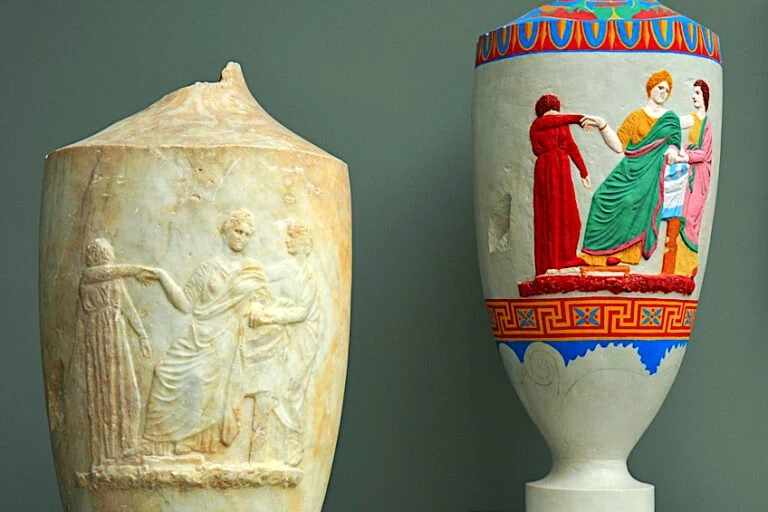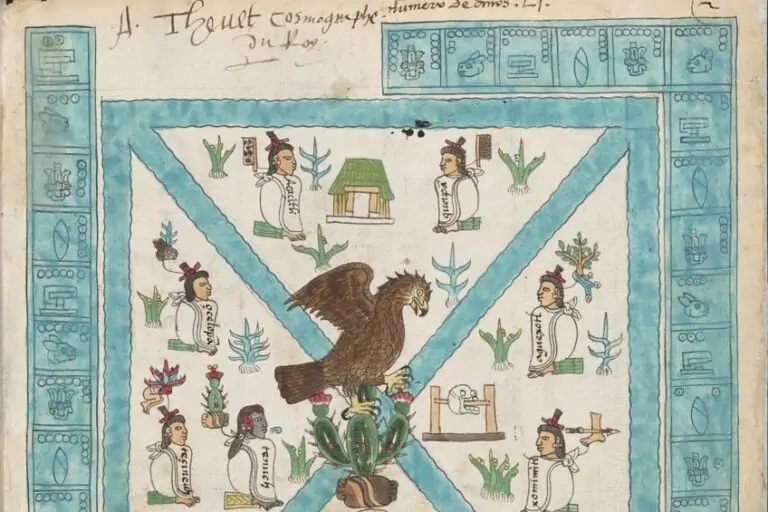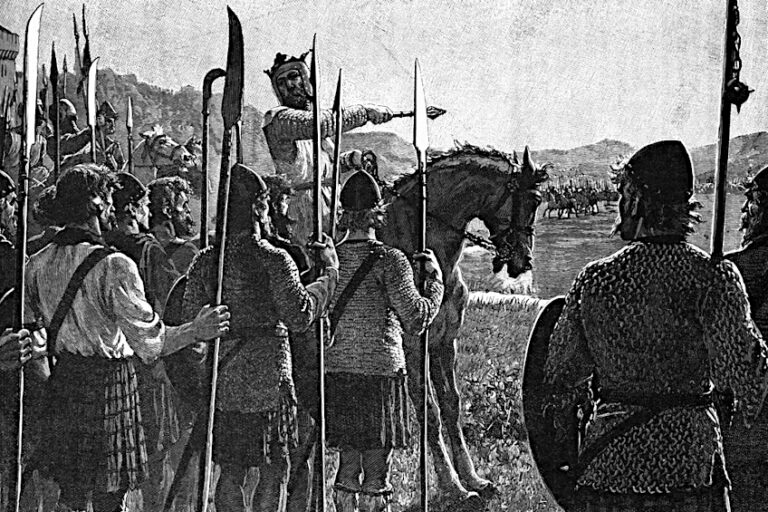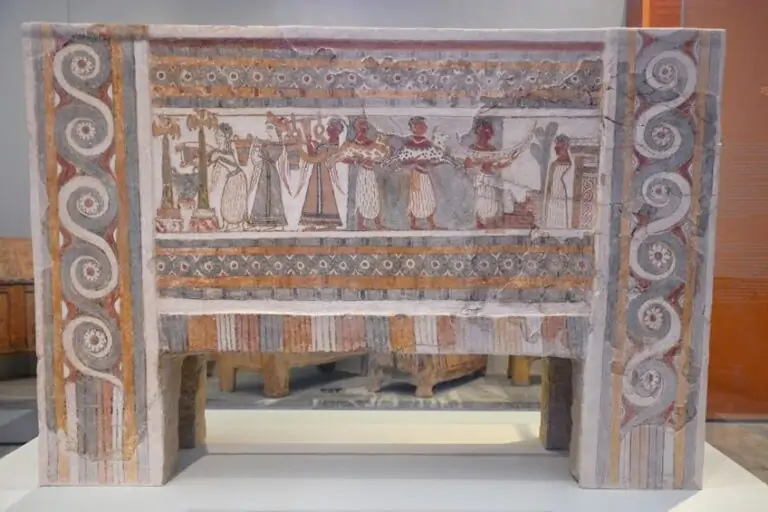Battle of Trenton – When Washington Crossed the Delaware
Why did the Battle of Trenton happen and why was the Battle of Trenton important in the Revolutionary War? This famous battle is considered a relatively small yet impactful battle of the American Revolutionary War. But, what happened in the Battle of Trenton, and who won the Trenton Battle? Join us as we examine all the facts about the Battle of Trenton, exploring the incidents that occurred leading up to battle, and answering related questions like, “when did the Battle of Trenton happen?”.
The History and Facts About the Battle of Trenton
| Battle Name | Battle of Trenton |
| War Associated With | American Revolutionary War |
| Date of War | 26 December 1776 |
| Location | Trenton, New Jersey, United States |
| Combatants | Americans vs. German Hessian auxiliary for Britain |
| Outcome | American victory |
In the early days of the revolution in America, the American Continental Army endured numerous losses and challenges, such as losing New York City to the British forces and having to withdraw to New Jersey. The army’s morale was very low at this time, and they badly wanted a win to lift the spirits of the troops and keep the Revolutionary War going.
Many soldiers’ enlistments in the army were about to come to an end, and a large number of them were hesitant to re-enlist due to the Americans’ lack of victories. A successful outcome at Trenton could potentially persuade these troops to continue fighting and recruit additional soldiers to the revolution.
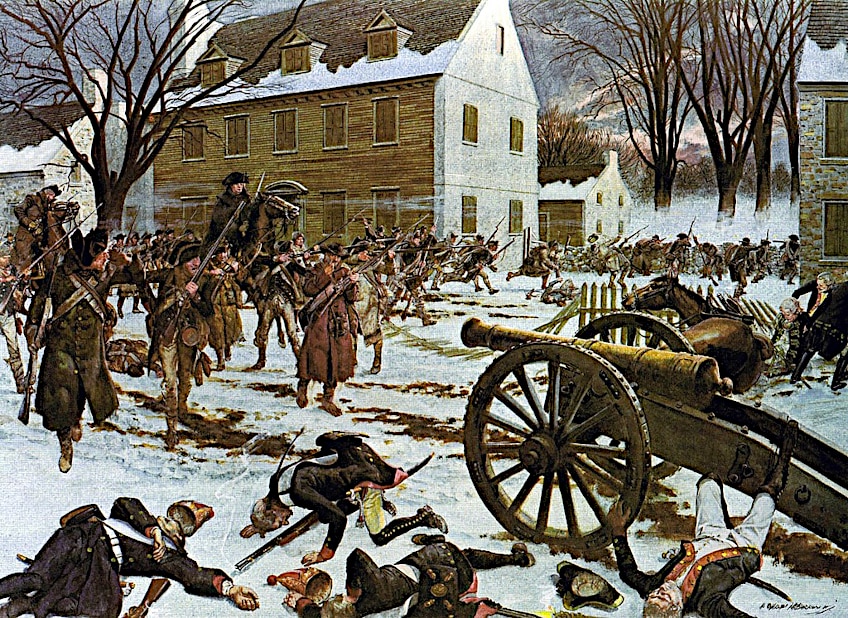 Battle of Trenton by Hugh Charles McBarron, Jr. (1975); Published by U.S. Government Printing Office; painting by Hugh Charles McBarron, Jr. (1902-1992), Public domain, via Wikimedia Commons
Battle of Trenton by Hugh Charles McBarron, Jr. (1975); Published by U.S. Government Printing Office; painting by Hugh Charles McBarron, Jr. (1902-1992), Public domain, via Wikimedia Commons
The American troops were desperate for supplies, particularly ammunition and nourishment. They wanted to seize the provisions of the Hessian outpost in Trenton in order to allow the army to survive the cold winter months. The British employed Hessian troops to crush the American Revolution and preserve the British agenda in the colonies. They were assigned with defending Trenton and preventing the revolutionaries from pushing further into New Jersey.
The Hessians were motivated by the opportunity to advance in their occupations and improve their quality of life by serving in the military.
Before the Battle
George Washington had placed an informant called John Honeyman at Trenton, masquerading as a Tory. This informant had previously worked at the Battle of the Plains of Abraham under Major General James Wolfe in Quebec on the 13th of September, 1759, and had no difficulty creating his Tory credentials. He worked as a bartender and butcher who did business with both the Hessians and the British. This allowed him to accumulate intelligence and persuade the Hessian sides that the Americans’ morale was so low that they were unlikely to try and attack Trenton.
Honeyman made arrangements to be arrested by the Continental Army, which had instructions to deliver him to Washington safely. After being interviewed by Washington, Honeyman was detained in a small hut in the early hours to be convicted as a Tory, but a little fire broke out close by, allowing him to “escape”.
Rahl, the Hessian leader, had been celebrating Christmas with his soldiers the night before the battle at the estate of Abraham Hunt, a rich farmer and merchant from Trenton. While Washington and his forces were getting ready for a surprise attack, Hunt pretended to be an ally Loyalist host, providing Rahl with a false sense of security.
Plan of the Continental Army Side
The Continental Army strategy called for synchronized strikes from three different directions. In order to thwart reinforcements arriving from the south, General John Cadwalader planned a diversionary assault against the British in Bordentown. General James Ewing would lead 700 militiamen across the Trenton Ferry River, capture the Assunpink Creek bridge, and stop enemy forces from fleeing. General Henry Knox would be in charge of the logistics of getting the army and its supplies across the Delaware river.
The largest assault force of 2,400 soldiers planned to traverse the river 14 kilometers north of Trenton and divide into two separate units, one led by Sullivan and the other by Greene, and launch an early-morning assault. Sullivan would assault the area from the south, while Greene would strike from the other direction.
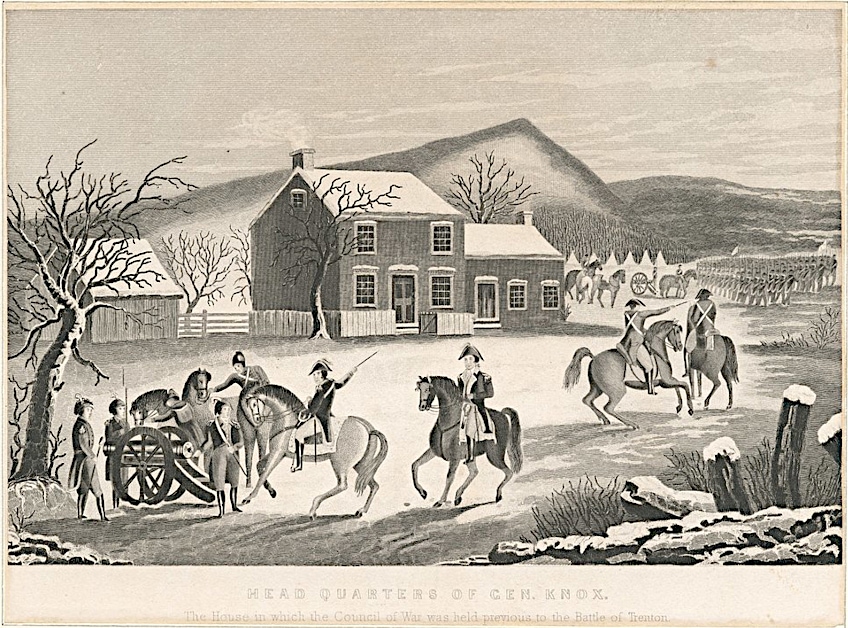 Depiction of the headquarters of Gen. Knox where the Council of War was held in the lead-up to the Battle of Trenton printed by R. Whitechurch and J. Halpin (unknown date); Scan by NYPL, Public domain, via Wikimedia Commons
Depiction of the headquarters of Gen. Knox where the Council of War was held in the lead-up to the Battle of Trenton printed by R. Whitechurch and J. Halpin (unknown date); Scan by NYPL, Public domain, via Wikimedia Commons
Depending on the operation’s effectiveness, the Americans could potentially then conduct separate strikes on New Brunswick on Princeton. During the week leading up to the actual battle, advance teams from the United States started ambushing enemy cavalry patrols, seizing dispatch horsemen, and striking Hessian barricades. In order to emphasize the peril his soldiers were in, the Hessian commander dispatched 100 troops and an artillery force to convey a message to the English commander at Princeton.
Washington sent Ewing and his Pennsylvania troops to gather intelligence on Hessian operations and capabilities. Instead, Ewing conducted three successful river incursions.
They assaulted a jäger station on the 17th and 18th of December, 1776, and set fire to many buildings on the 21st of December. Washington kept a vigilant watch on every potential crossing near the Continental Army camp on the Delaware, believing that if the water froze over, William Howe was going to launch a strike from the north. 2,000 men headed by General Sullivan landed at Washington’s camp on the 20th of December, 1776. They were under the leadership of Charles Lee and had been making their way slowly across the northern side of New Jersey when Lee was apprehended. On the same day, a further 800 men led by Horatio Gates came from Fort Ticonderoga.
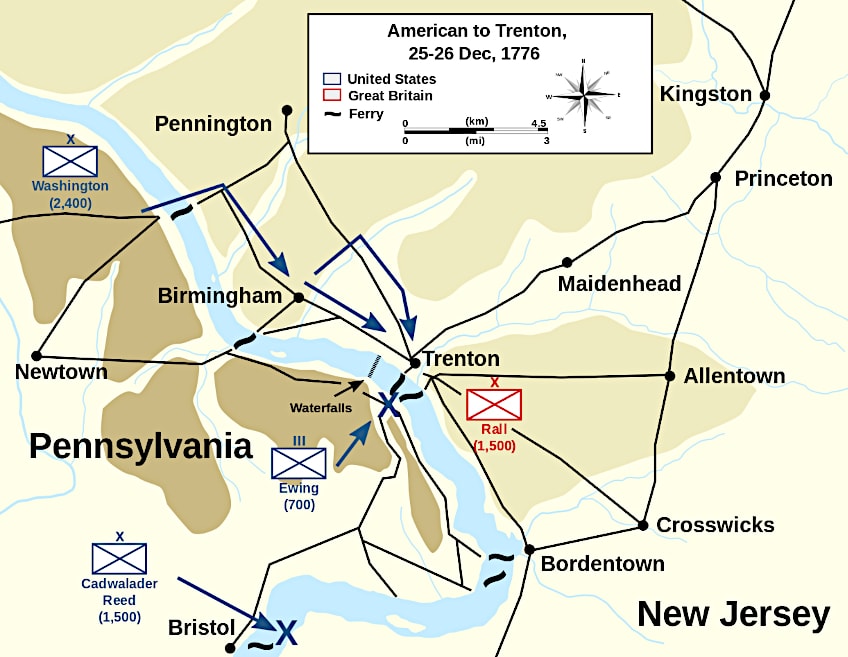 Map showing the Continental Army crossing Delaware and march to Trenton, Dec 26, 1776; Oneam, CC BY-SA 3.0, via Wikimedia Commons
Map showing the Continental Army crossing Delaware and march to Trenton, Dec 26, 1776; Oneam, CC BY-SA 3.0, via Wikimedia Commons
Plans of the Hessian Side
The Hessians arrived at Trenton on the 14th of December, 1776, to construct their winter quarters. Trenton was a tiny town with around 100 dwellings and only two main streets, King and Queen Streets. Rahl’s higher-up, Carl von Donop, proceeded toward Mount Holly on the 22nd of December to deal with the opposition in New Jersey, where he battled against a few New Jersey militia on the 23rd of December. Donop, who detested Rahl, was hesitant about handing him charge of Trenton.
Rahl was notorious for being boisterous and unable to properly speak English, but he also happened to be a 36-year veteran with extensive fighting experience.
His requests for assistance had been denied by General James Grant, the British commander who despised the American insurgents and considered them incompetent troops. Despite all of Rahl’s expertise, the Hessians did not view him very favorably. Trenton lacked any city walls and adequate defenses, which was common in American cities. Several of the Hessian officers urged Rahl to reinforce the town, and a pair of his engineers suggested building a defensive structure at the town’s upper end and fortifications all along the river banks. Rahl disapproved of the engineers’ designs. When pressured again to reinforce the town, Rahl said, “Let them come. We’ll attack them with bayonets.”
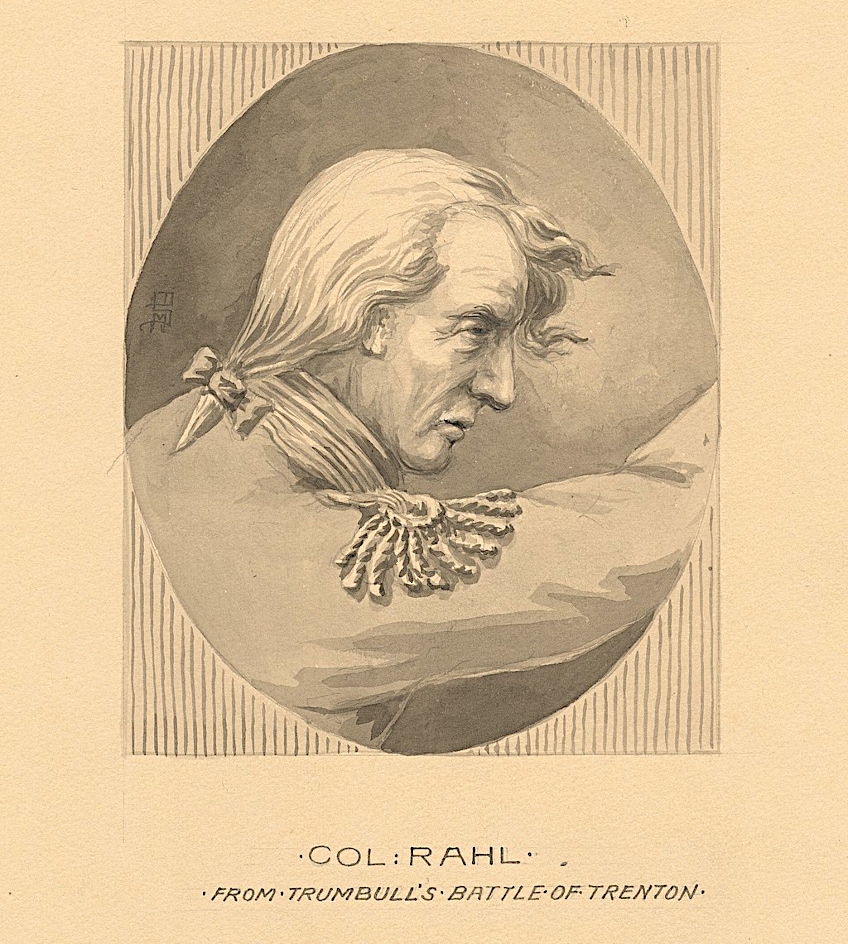 Portrait of Colonel Johann Gottlieb Rahl by an unknown artist; Scan by NYPL, Public domain, via Wikimedia Commons
Portrait of Colonel Johann Gottlieb Rahl by an unknown artist; Scan by NYPL, Public domain, via Wikimedia Commons
As Christmas approached, Loyalists reported to Trenton that the Continental Army was planning an attack. Deserters from the United States side informed the Hessian commanders that provisions were being made ready for their advance over the river.
Rahl rejected such discussion as foolishness in public, but in correspondence with his superiors, he expressed concern about an impending attack. He warned Donop that he was “vulnerable to being attacked at any time”. Rahl declared the town “indefensible” and requested that British soldiers be stationed in Maidenhead. This would serve to protect the roads against Americans near Trenton. The request was turned down. The commanders began to share Rahl’s concerns as the Continental troops damaged Hessian supply routes. “We have not rested a single night since we arrived here”, one complained.
On the 22nd of December, 1776, Grant received word from an informant that Washington had convened a council of war; Rahl was advised to be on his guard. Lossberg, Knyphausen, and Rahl regiments made up the bulk of the Hessian contingent of 1,500 men. Because of the bad weather, they were unable to send out any patrols that night.
Crossing of the Delaware River
The army was already later than planned when it landed on the Delaware River’s banks, and clouds started to develop above them. It started to rain, and then as the temperature fell, the rain turned to sleet, and eventually snow. With John Glover in command, the Americans proceeded to cross the river. The soldiers were transported on Durham boats, while the artillery and horses were transported on big ferries.
Several of the men fell overboard throughout the crossing, which included Colonel John Haslet. Haslet was swiftly hauled out of the freezing waters. No one perished during the trip, and all of the artillery arrived safely.
Two minor infantry detachments were dispatched ahead of the main divisions. They put up barriers ahead of the main troops and were to arrest everyone who entered or exited the town. The severe weather stalled the landings in New Jersey, and Washington accepted that a pre-dawn strike would not be possible. The Americans suffered another blow when Generals Ewing and Cadwalader were not able to join the offensive due to the terrible weather conditions which hindered their passage. The army started marching toward Trenton around 4:00 a.m.
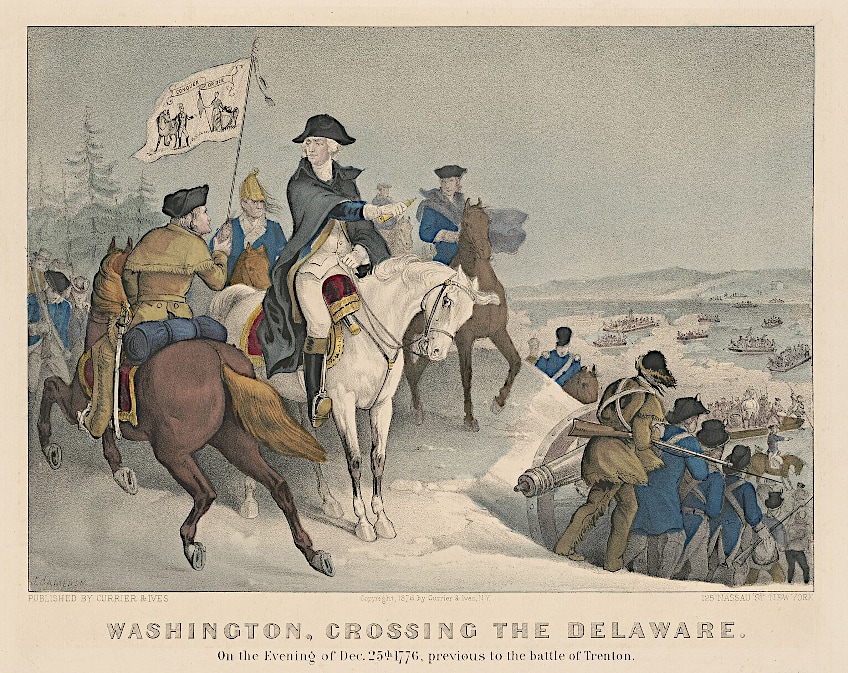 Washington crossing the Delaware: on the evening of Dec 25th. 1776, previous to the battle of Trenton by an unknown artist (1876); Popular Graphic Arts, Public domain, via Wikimedia Commons
Washington crossing the Delaware: on the evening of Dec 25th. 1776, previous to the battle of Trenton by an unknown artist (1876); Popular Graphic Arts, Public domain, via Wikimedia Commons
Several local civilians volunteered and served as guides along the way. The footing was slick, but it was at least flat, which made things less treacherous for the artillery and horses. Because many of the soldiers lacked boots, they had to wrap rags around their feet. Several of the soldiers’ feet were bleeding, which turned the snow a dark red color. On the march, two men passed away.
Washington galloped up and down the marching line, urging the soldiers to keep going. General Sullivan sent a messenger to inform Washington that the rain was soaking his men’s gunpowder. “Tell General Sullivan to employ the bayonets”, Washington said. “I am determined to capture Trenton”.
The main divisions rejoined with the advance groups around three kilometers outside of the town. They were taken aback by the abrupt arrival of 50 armed soldiers, but they soon realized that they were Americans. They had not even known about Washington’s plan to take Trenton and struck a Hessian garrison that day led by Adam Stephen.
Washington feared that the Hessians would now be on alert because of their attack and screamed at Stephen, “You Sir, may have just completely ruined all my intentions by putting them on alert with your attack”.
Regardless, Washington directed that the advance continue toward Trenton. After the earlier attack, Rahl assumed that it was the attack Grant had informed him about, and therefore was under the impression that there would be no further attacks that day.
The Battle of Trenton
The Hessians established an outpost on Pennington Road, about one and a half kilometers northwest of Trenton, on the morning of the 26th of December. Washington led the charge, galloping in front of his troops. As Lieutenant Andreas Wiederholdt, the outpost’s Hessian commander, exited the shop, one of the Americans fired at him but missed. Wiederholdt yelled, “The enemy!”, as additional Hessians rushed out. The American troops discharged three volleys, while the Hessians fired one back.
Washington sent the Pennsylvania Riflemen to block the road leading to Princeton, and there they launched an attack on the Hessian garrison. Wiederholdt quickly figured out that this group was far more than a simple raiding party, and when he saw other Hessians fleeing the outpost, he ordered his troops to do the same.
Both Hessian detachments executed orderly withdrawals, shooting as they did so. A volunteer battalion from the Lossberg Regiment joined them on the high ground at Trenton’s northern end. They fought the Americans by retiring slowly, maintaining a constant fire, and making use of residences as cover.
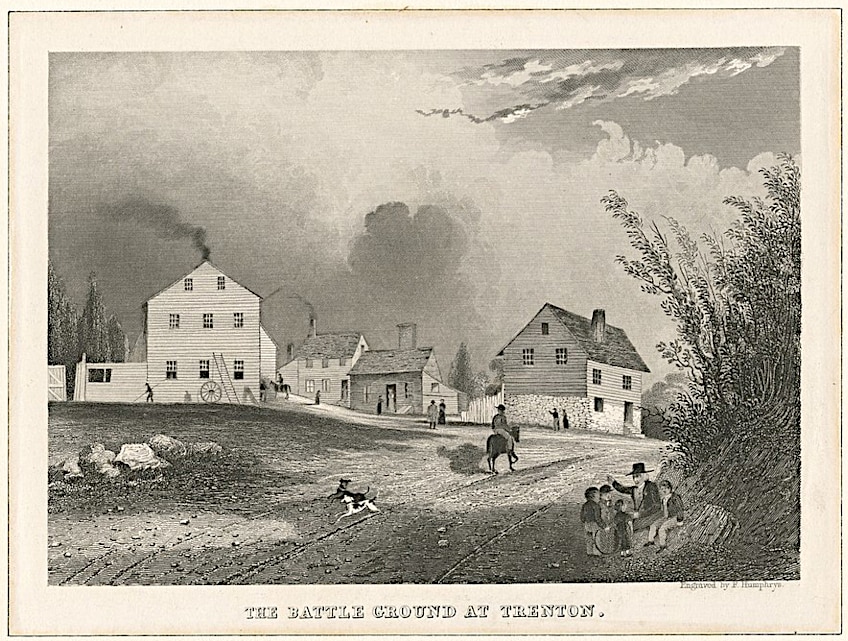 The Location of the Battle Ground at Trenton by F. Humphrys (1840); Scan by NYPL, Public domain, via Wikimedia Commons
The Location of the Battle Ground at Trenton by F. Humphrys (1840); Scan by NYPL, Public domain, via Wikimedia Commons
The Southern Column
General Sullivan led the U.S. southern column into Trenton through the deserted River Road and closed the sole crossing across Assunpink Creek in order to cut off the Hessian retreat. Sullivan temporarily halted his march to allow Greene’s division time to remove the Hessians from their northern strongholds. Soon after, they resumed their offensive, striking the Hermitage, residence of Philemon Dickinson, where 50 jägers had been positioned under the leadership of Lieutenant von Grothausen.
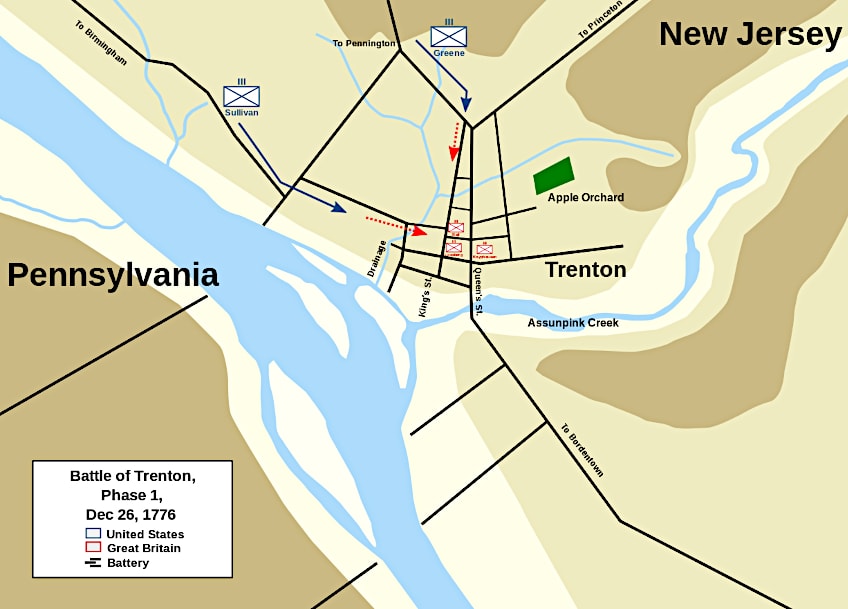 Map showing the first phase of the Battle of Trenton, Dec 26, 1776; Oneam, CC BY-SA 3.0, via Wikimedia Commons
Map showing the first phase of the Battle of Trenton, Dec 26, 1776; Oneam, CC BY-SA 3.0, via Wikimedia Commons
Von Grothausen sent 12 jägers toward the advancing guard but only made it only a couple hundred yards when he noticed a column of Americans approaching the Hermitage.
He was accompanied by the remainder of the jägers as they returned to the Hessian quarters. They withdrew and bolted after exchanging one round, some attempting to make their way across the stream by swimming, while others fled over the bridge, which was yet to be cut off. Washington proceeded to high ground north of Queen and King streets to observe the engagement and guide his forces as Sullivan and Greene’s armies surged into town.
By this point, US artillery from the Delaware River’s other side had arrived and wiped out the Hessian positions.
At King and Queen Streets
The various Hessian regiments proceeded to prepare for conflict as soon as the alarm went off. The regiment under Rahl, together with Lossberg’s regiment, assembled on lower King Street, whereas the regiment under Knyphausen formed near the lower end of Queen Street. Rahl’s brigade adjutant, Lieutenant Piel, awoke his captain to find the rebels had occupied the conjunction of the town’s main streets. The engineers had suggested erecting a defensive structure here. Rahl directed that his troops position themselves at King Street’s lower end, that the regiment under Lossberg prepared itself to advance up Queen Street, and that the Knyphausen’s unit was to wait as a backup for Rahl’s push up King Street.
The US artillery positioned at the intersection of the two streets was quickly activated. The Hessians formed lines and started to move up the street, but their positions rapidly fell when American and Mercer’s troops who had occupied residences on the street’s left side opened fire. The Hessians broke ranks and fled. Rahl authorized the firing of two three-pound guns. Within a few minutes, around half of the Hessians operating the weapons were shot dead by the US artillery.
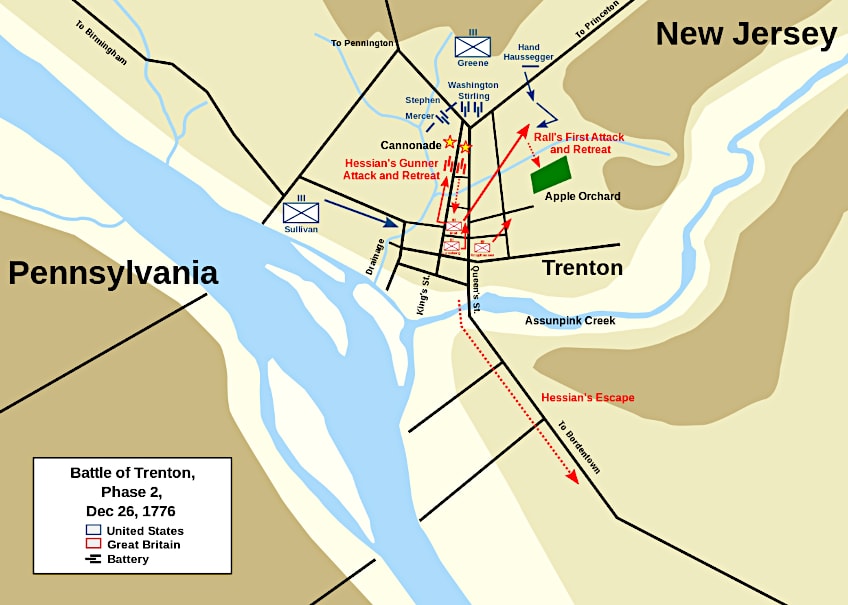 Map showing the second phase of the Battle of Trenton, Dec 26, 1776; Oneam, CC BY-SA 3.0, via Wikimedia Commons
Map showing the second phase of the Battle of Trenton, Dec 26, 1776; Oneam, CC BY-SA 3.0, via Wikimedia Commons
The Americans took their cannons when the soldiers took refuge behind homes. After the cannons were seized, men led by George Weedon progressed down King Street. All Hessian efforts to march along Queen Street were thwarted by cannons under the leadership of Thomas Forrest. One of Forrest’s artillery was rendered inoperable due to a damaged axle. Knyphausen’s regiment split from the Rahl and Lossberg regiments. These regiments were forced to retreat to an open space outside the town, suffering significant losses from musket fire. Americans led by Sullivan started to overpower the Hessians in the southern half of Trenton.
The Collapse of the Hessian Resistance
The Hessians who had fled to the field tried to reassemble and make one more effort at taking the town in order to attempt their getaway. Rahl made the decision to strike the American flank on the peaks north of town. “Advance! Advance!”, shouted Rahl, and the Hessians started moving, with the band playing bugles and drums to lift their spirits.
Washington observed the Hessians nearing the US flank, as he still had the high ground. He maneuvered his forces into battle formation against the Hessians. The two Hessian battalions started to advance toward King Street but were met with American fire from three different directions.
Some of the Americans took on defensive positions inside their homes, reducing their vulnerability. Some civilians fought alongside the Hessians. Despite this, they persisted, recapturing their weaponry. Knox observed the Hessians retaking the guns at the top of King Street and commanded his soldiers to seize them. Six of his men ran and captured the guns, directing them at the Hessians after a short scuffle. It was halted because the majority of the Hessians were unable to fire their weapons. The Hessians’ formations disintegrated and they dispersed.
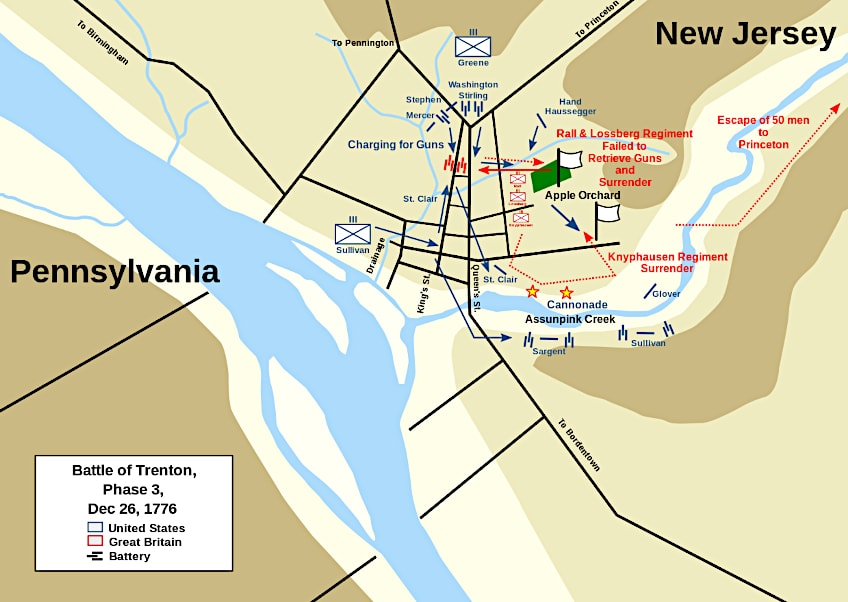 Map showing the third phase of the Battle of Trenton, Dec 26, 1776; Oneam, CC BY-SA 3.0, via Wikimedia Commons
Map showing the third phase of the Battle of Trenton, Dec 26, 1776; Oneam, CC BY-SA 3.0, via Wikimedia Commons
Rahl was killed instantly. Washington led his forces down from his elevated position. The majority of the Hessians fled into nearby orchards, with the Americans closing in.
The Hessians were immediately encircled and provided with terms of surrender, to which they consented. Despite being ordered to accompany Rahl, the remnants of Knyphausen’s regiment made their way in the opposite direction. They attempted to flee across the bridge, but it had been captured. The Americans stormed in rapidly, thwarting a Hessian effort to breach their lines. The regiment submitted barely minutes after the other members of the brigade, encircled by Sullivan’s soldiers.
Capture and Casualties
The Hessian troops suffered the loss of 22 men, including Colonel Johann Rahl, with a total loss of 896 prisoners, of which 83 were wounded. Two Americans died during the march to the battle, while a further five were wounded in the actual battle, which included James Monroe, the future president, who received a near-fatal shot to the shoulder.
Additional losses suffered by the Americans in the days that followed due to exposure, exhaustion, and illness may have actually raised their death toll above the Hessians.
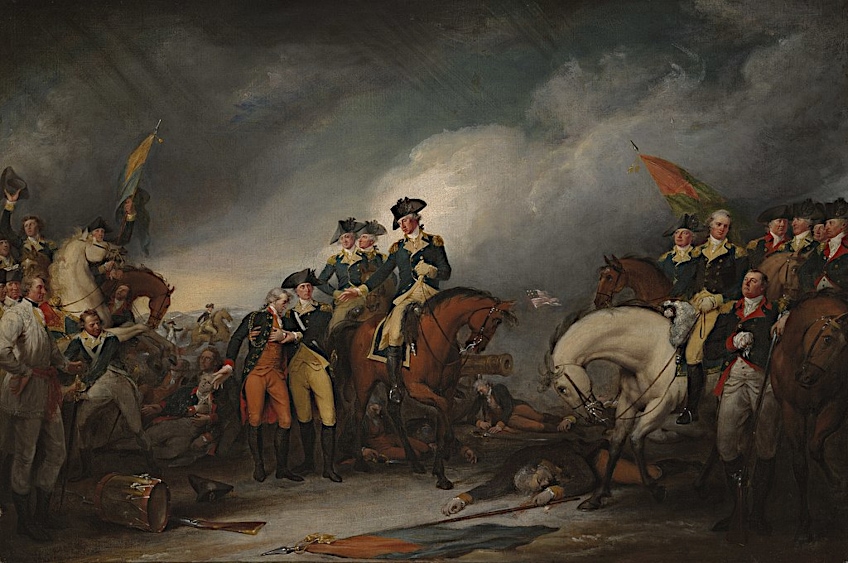 The Capture of the Hessians at Trenton, December 26, 1776 by John Trumbull (between 1786 and 1828); John Trumbull, Public domain, via Wikimedia Commons
The Capture of the Hessians at Trenton, December 26, 1776 by John Trumbull (between 1786 and 1828); John Trumbull, Public domain, via Wikimedia Commons
The captive Hessians were taken to Philadelphia and then on to Lancaster, and they were relocated to Virginia in 1777. Rahl was critically wounded and passed away at his headquarters later that night. The Americans killed all four Hessian colonels in Trenton. Lossberg’s regiment was essentially withdrawn from British service. Parts of Knyphausen’s regiment fled to the south, but Sullivan apprehended 200 more soldiers, as well as the unit’s artillery and provisions. They also confiscated roughly 1,000 weapons and ammo.
The Americans also took their entire supply of food, including quantities of bread, salted and dried meats, and liquor, in addition to boots, shoes, clothes, and bedding, which were just as important to the motley Continental soldiers as guns and horses.
The Aftermath of the Battle of Trenton
Following the fall of the Hessians, Washington is believed to have shaken a young officer’s hand and stated that it was an incredible moment for the nation. Lieutenant Andreas Wiederhold, who documented Rahl’s preliminary errors, was interviewed by General Washington on the 28th of December. Washington soon discovered that Ewing and Cadwalader had not been able to make the crossing, leaving their exhausted army of 2,400 men stranded. Washington acknowledged he didn’t have the resources to strike New Brunswick and Princeton without the additional 2,400 men.
By midday, Washington’s army had crossed the Delaware and returned to Pennsylvania, carrying captives and seized provisions with them.
 Hessian soldiers captured during the battle at Trenton en route to Philadelphia by Daniel Berger (1784); Daniel Berger, Public domain, via Wikimedia Commons
Hessian soldiers captured during the battle at Trenton en route to Philadelphia by Daniel Berger (1784); Daniel Berger, Public domain, via Wikimedia Commons
The victory at Trenton spurred Washington to traverse the Delaware River again just a week later in order to entice British soldiers south from Trenton. As a result, the Americans obtained an edge and were successful at the Battle of Princeton once more. In these battles, Washington demonstrated his ability to unite militias from several colonies into a national army. Following that, the Continental Army advanced toward Morristown to spend the winter there.
The Legacy of the Battle of Trenton
This relatively small but important battle, like the subsequent Cowpens battle, had far-reaching consequences. The Patriot’s victory boosted the Continental Congress’s morale by demonstrating that colonial armies could beat them in the days to come. It also resulted in a surge in enlistments in the Continental Army troops.
 Poster satirizing the recruitment drive in the wake of Washington’s capture of Trenton (1777); British Museum, Public domain, via Wikimedia Commons
Poster satirizing the recruitment drive in the wake of Washington’s capture of Trenton (1777); British Museum, Public domain, via Wikimedia Commons
The colonials managed to diminish the fear and anxiety that the Hessians had instilled earlier that year following the combat in New York by conquering a European force.
Howe was taken aback by the Patriots’ ability to surprise and overthrow the Hessians. The works of Thomas Paine along with additional successful campaigns by the New Jersey Militia boosted colonial sympathy for the Revolutionary War substantially at this time. While leading the attack along King Street, two important US officers were wounded: General Washington’s cousin, William Washington, and later President of the United States, Lieutenant James Monroe.
The Trenton Battle Monument, located at “Five Points” in Trenton, is a memorial to this American triumph. Every year, locals reenact the Delaware River crossing and the battle that followed.
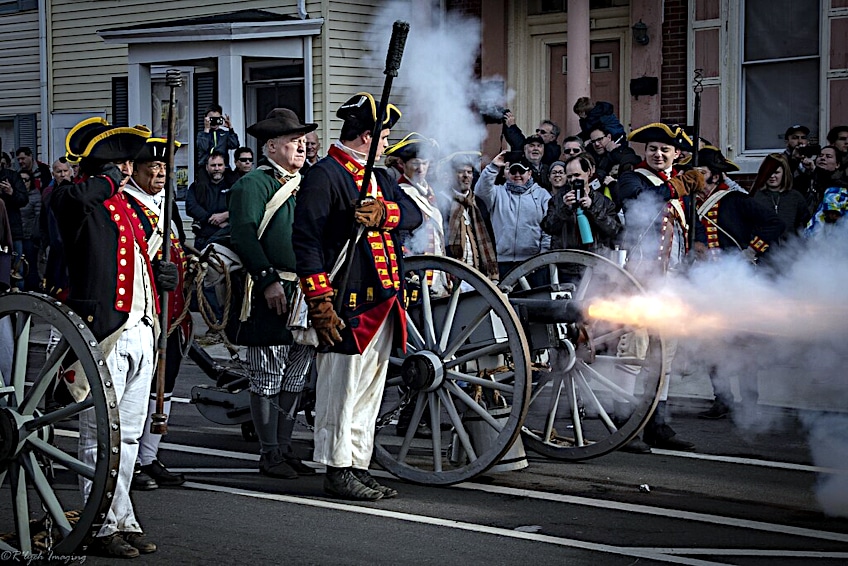 Modern re-enactment of the Battle of Trenton in 2019; R’lyeh Imaging, CC BY 2.0, via Wikimedia Commons
Modern re-enactment of the Battle of Trenton in 2019; R’lyeh Imaging, CC BY 2.0, via Wikimedia Commons
The Battle of Trenton in Art
Emanuel Leutze, a German-American artist, made Washington Crossing the Delaware in 1851. It is on display at the Metropolitan Museum of Art and is considered to be one of the most iconic American paintings ever produced. It created quite a stir when it was originally shown in the United States and Europe. Leutze anticipated that it would incite revolutionary feelings in Germany.
It was sent to New York City after half a year in Germany, where the New York Mirror newspaper described it as “the most effective and majestic painting ever to be exhibited in the United States”. It remains to be one of the most popular artworks at the Metropolitan Museum of Art.
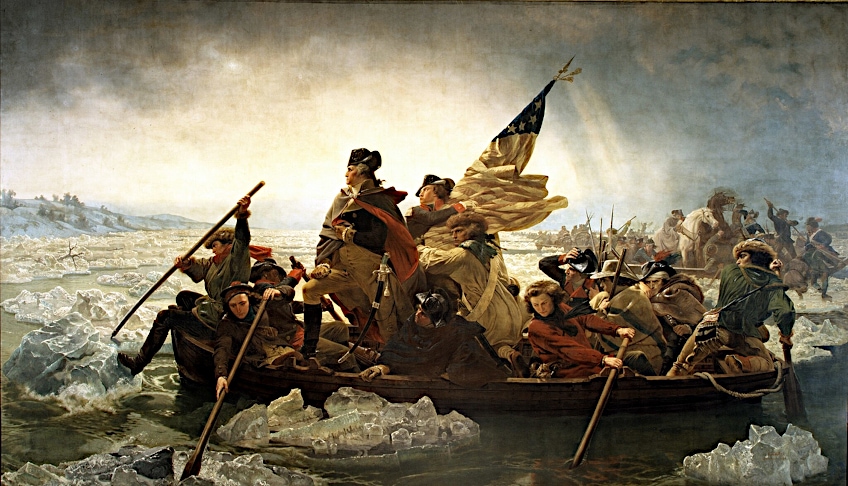 Washington Crossing the Delaware by Emanuel Leutze (1851); Emanuel Leutze, Public domain, via Wikimedia Commons
Washington Crossing the Delaware by Emanuel Leutze (1851); Emanuel Leutze, Public domain, via Wikimedia Commons
That wraps up our look at the facts about the Battle of Trenton. Washington devised a brilliant scheme to startle the British, seize their supplies, and boost the morale of the American Army after encouraging his enlisted troops to stay for one more push. The plan was to transport his troops across the Delaware on Christmas day and then attack the Hessian stronghold at Trenton. At first, planned as a three-pronged assault, the plan was thwarted by an icy river, forcing two of Washington’s columns to retreat. Only the main unit, led by Washington, crossed the challenging passage 14 kilometers north of Trenton. The American army, that the British mistook for having been defeated in the battle, captured a significant garrison while suffering only a few fatalities of its own. In the course of the operation, the Americans were able to capture crucial supplies such as clothing and food.
Frequently Asked Questions
Who Won the Trenton Battle?
The American Continental Army, commanded by General George Washington, effectively struck and beat Hessian soldiers positioned in Trenton in this famous battle. It started as a surprise attack on the day after Christmas. Washington and his army advanced on Trenton after crossing the cold Delaware River the day before, surprising the Hessian soldiers, who were completely unprepared. The Americans easily overtook their garrison, capturing 896 prisoners and obtaining essential provisions and weaponry. The American victory at Trenton gave the Continental Army a much-needed morale boost after an abundance of setbacks in the early stage of the Revolutionary War. It also exemplified Washington’s tactical leadership, and helped persuade more colonists to participate in the rebellion.
What Happened in the Battle of Trenton?
The Hessian troops comprised mercenaries from Germany who were brought in to fight on behalf of the British. The Hessians were led by Colonel Johann Rall and had been positioned at Trenton for a number of weeks, hoping that the cold weather would keep the American Army at bay. George Washington and his forces, though, caught the Hessians off guard in the early morning hours of the 26th of December. The Americans overwhelmed the Hessian fortifications with both bayonets and muskets. Despite considerable Hessian resistance, the fight ended in less than an hour.
Why Was the Battle of Trenton Important to the Revolutionary War?
There are many reasons why this is regarded as an important battle in the Revolutionary War, despite being a somewhat smaller conflict. The victory at Trenton provided the American soldiers, as well as the general population, renewed faith and hope that they stood a chance to actually win the war. This was especially critical early in the conflict when Americans were largely outnumbered and lacked adequate resources. The battle also demonstrated that the Continental Army could launch effective operations against a well-equipped opponent. The American victory at Trenton persuaded France to join the American side in the war. Because the French began to consider the Americans a significant threat to the ruling British government, they subsequently decided to offer financial and military assistance to the Americans’ revolutionary efforts.
Why Did the Battle of Trenton Happen?
The British had conquered New York City in the autumn of 1776, forcing the American soldiers to flee into Pennsylvania. The Americans were discouraged, tired, and concerned about running out of provisions and deserters. General George Washington felt that the American Revolutionary cause was in danger of failing, so he decided to execute an unexpected strike on the Hessian stronghold at Trenton.
When Did the Battle of Trenton Happen?
Before the actual battle took place, Washington led his men across the freezing Delaware River on Christmas day in 1776. The battle took place the following day, with the Americans hoping the Hessians would be caught by surprise and tired from celebrating Christmas the night before. The battle did not last long, though, and the Americans claimed victory.

I am deeply passionate about history and am constantly fascinated by the rich and complex stories of the past. As the editor-in-chief of learning-history.com, I have the opportunity to share this passion with a wide audience through the creation and distribution of engaging and informative content about historical events, persons, and cultures. Whether it’s through writing articles and blog posts or creating videos or podcasts, I strive to bring the past to life in a way that is both accurate and enjoyable. My expertise in history, combined with my strong writing and communication skills, allows me to effectively communicate complex historical concepts and make them accessible and interesting to a wide range of readers. I am truly grateful for the opportunity to share my love of history with others through my work on learning-history.com.


